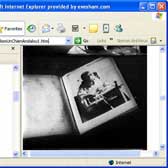.. or deciphered as: Lost in translation points to the absence of the ideal.
drain magazine published again an interesting opening article in its recent issue Lost In Translation.
Gregory Minissale embarks in his essay from Vermeer’s The Lacemaker as an examplary translation of mental activity – transfered into the inbetween spaces of the lace – the unrepresentable which is lost within / the inherent disapperance occuring through methods of ‘framing’ introduced along the way of translating.
His interpretation of the lace as being defined through the loss of the inbetween spaces becomes related to the disclosure equally of pattern and pattern of loss.
| Translation as the framing device to reveal both the last and the next frame, but never an explicit interpretation. This way the attitude of framing either through the ‘mise en abyme’ (image which depicts itself as an image) or the deliberate embedment, and equally the steady translation into digization create distancing effects which generate various levels of translation – framing as the allowance of an unfolding of a mental space upon itself. Thus the image / translation is now open to become fluid and might show its limitations of overlappings of one perception with another, like lace is folded. |  screen grab of a film still, Un Chien Andalou, 1928, a photograph of Vermeer’s The Lacemaker in a book (link) |
…
The hyperactivity of meaning continually displaces the permanence of the image in space and at the same time in the synthesis of meaning. The image is a journey, it is not a destination.
The translations weave the contained myths equally into the new medium crossing thus the threshold not only on a mental but simulataneously on a physical level. The digitisation of the web and our changing attitudes of consumption also might have to adjust to that attitude of ‘throughness’:
..
The gaze and its engagement within frames is not a thing frozen in time (in a frame) but is a process of becoming within the frames, which mark its trajectory and the thought behind the eyes of the gaze.
In defining that each frame might be a potential threshold of further meaning, an unperceived point of view the paradox of gain and loss becomes perceptible: … It is continually lost and found in translation; each translation is a resonance of another. It is not the object itself [..] but its relation to the translation of it, thus what we lose in translation is the [..] qua object and the gaining of the relation of the object to its perception.
So it is the frame and the attitude of framing which is left over for the one who was once called the author. It is the shifting of meaning through the appearance and disapperance of those frames which are perceptible. This questions at the same time permanence and stability, but equally allows a representation of reality as a process, or thought as a process of folding and unfolding.
The paradoxical of this situation highlights both movement and no movement – the questioning of reality and truth – the illusion of a visual universe and the reality of a virtual one. Demanding for our awareness of the element of self reflexibility of digital creations …
..
Frames within frames, thought unfolds within thought, translation unfolds within translation, the Web unfolds within itself, as we continually recreate ourselves causing there to be a map of loss we are only just beginning to unfold.
The premise, again, is image creation from within itself.
Beauty and danger of the processual …
